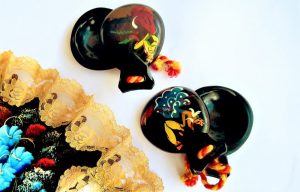Phonograph
Phonograph, also known as a disc player, is an instrument used to reproduce sounds through the vibration of a pencil or needle, following a slot in a rotating disc. A phonographic disc, or register, is responsible for storing a replica of sound waves as a series of undulations in a sinuous groove inscribed on its rotating surface by the stylus. When the recording is played back, another pen responds to the ripples and its movements become sound.

Related topics
Gramophone
What is a phonograph?
The phonograph was the first device that existed with the ability to record and reproduce sounds. It is also known as a gramophone or disc player.
Etymology
The word phonograph comes from the Greek word φωνη that means sound or voice and from γράφος that has as meaning to write. In modern times it was called a record player.
Characteristics of the phonograph
The main characteristics of the phonograph are as follows:
- The instrument was equipped with an analog mechanical recording system.
- The sound waves were transformed into mechanical vibrations through a mechanical transducer.
- It had a helical groove on top of a cylinder which, when placed in reverse, produced sounds.
- They were made of cardboard covered with tin, but then they were made of cardboard with paraffin.
- It had a thread in the axis on which the cylinder was installed, and the rotation produced a lateral displacement making the printed furrow develop in the form of a spiral until the end of the sheet.
- All models of Edison phonographs had similar architecture, with the engine hidden inside the box, the platform above, a lid with handle, and the trumpet that was separable from the machine.
- The phonograph’s operation is smooth and powerful, and it was capable of producing a clean and magnificent sound.
History
Although experimental mechanisms for reproducing sounds had appeared in 1857, the invention of the phonograph is generally attributed to the American inventor Thomas Edison in 1877. His first recordings were cracks engraved on a sheet of tin paper by a vibrating pencil; the tin paper was wrapped around a cylinder that spun as sounds were recorded.
Improvements to the device continued with Edison’s process, among which the innovation of Emil Berliner in 1887 stands out, who traced lines of sound in spiral on a flat disc instead of on a propeller on a cylinder. A negative was made from the flat master disk, and this was then used as a mold to make copies that reproduced the original master disk. These records, as they were generally called, were able to be reproduced on a playback machine called a Gramophone.
At the beginning of the 20th century, the methods for molding discs were improved, and in 1915 the record of 78 revolutions per minute, with a playback time of approximately 4 minutes per side, was the standard model. In the early 1920s, electric loudspeakers were adopted to amplify the volume of reproduced sound.
In 1948, Columbia Records introduced the LP, which could produce up to 30 minutes of playback time per side. Then 45 RPM discs were introduced, which could be played for up to 8 minutes per side. Stereo phonographs were made that were able to reproduce sound without distortion – a component of what is known as a high fidelity sound system.
Who invented the phonograph?
The phonograph was invented by Thomas Alva Edison who announced the invention of his first phonograph on November 21, 1877. He was able to present his phonograph in front of the society for the first time on November 29, 1877 and patented it on February 19, 1878. He got the idea to create it when he was working in a telegraphic system, observing a correlation that existed between the movement of a drum with perforations and the sound associated with its rotation.
When Edison realized the demand for entertainment and music reproduction, he began a race to patent the reproduction rights of the singers and performers of the time, perfected the apparatus, attended fairs, and established an extensive distribution network. His phonograph was then an international success, amid legal battles with competitors, dishonest employees and even some of his own lawyers, who betrayed him.
What is the phonograph for?
Edison thought it could work to make recordings always spinning at the same speed. His system was similar to that of the autograph phono, but the phonograph used a metal needle to record the sound like a furrow on a thin sheet of tin which was a very soft metal wrapped in the cylinder. It was used to reproduce sounds that had previously been recorded through vibration waves that recorded the sound in a spiral groove on a surface which rotated while a reproduction pen tracked the groove.
How to cite this article?
Briceño V., Gabriela. (2019). Phonograph. Recovered on 3 January, 2025, de Euston96: https://www.euston96.com/en/phonograph/









